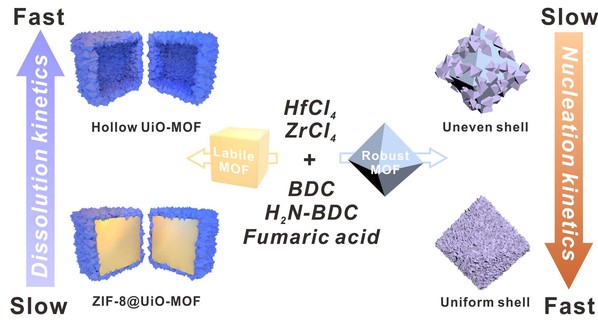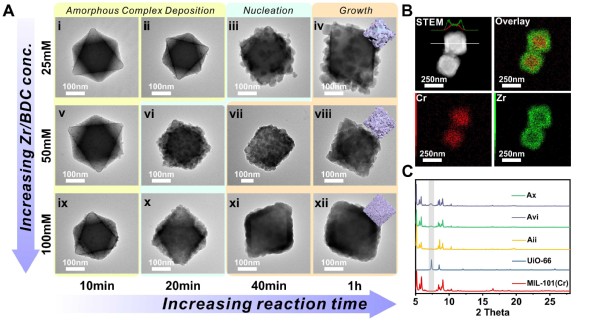Recently, SPST Assistant Professor Li Tao’s research group overcame the key obstacles of constructing core-shell type metal-organic framework (MOF) composite materials. The work, “Uncovering Two Kinetic Factors in the Controlled Growth of Topologically Distinct Core-Shell Metal-Organic Frameworks,” was published in Chemical Science.
Metal-organic frameworks (MOFs) are a broad class of porous materials constructed through hierarchical molecular assembly of metal building units and organic linkers. Their high designability paves the way for many potential applications. However, many MOFs with excellent gas adsorption and separation performance tend to suffer from poor stability, while MOFs with high stability are often gifted at sorption. Although pursuing new well-rounded MOFs continues to be of interest, an alternative is to combine the merits of different MOFs into one material through core-shell construction. For example, encasing a fragile but multifunctional MOF core in a robust MOF shell can dramatically increase its stability while maintaining its inherent sorption properties. However, growing a dense MOF shell on another topologically distinct MOF is a nontrivial task because of their mismatched unit cell parameters and symmetry. To date, only a handful of examples in the literature show the successful construction of such core-shell MOFs.
Here, two kinetic factors, nucleation kinetics and dissolution kinetics, are revealed to be two keys to overcoming this challenge. Through kinetic control, Li Tao’s research group demonstrated the growth of four types of Zr/Hf-MOF shells uniformly and contiguously on seven different core MOFs. Through a set of controlled experiments they discovered for the first time that fast nucleation kinetics during heterogeneous nucleation reactions was key to facilitating uniform shell growth to form high-quality core-shell MOF materials. In addition, they also discovered that when labile MOF materials (ZIF-8 in this study) were used as core, the dissolution kinetics of core is another key parameter that determines the successful growth of the shell. Through systematic control of the dissolution rate of ZIF-8 seeds during the shell growth process, different morphologies (hollow shell, yolk-shell, and core-shell) can be accessed. The authors further demonstrated that the MOF shells can serve as a bridging layer for secondary modification of MOF surfaces, which can significantly impact the catalytic properties of metal nanoparticle-MOF composites. This work is a major step forward for the design and synthesis of complex multifunctional MOF composites for various applications.
The work was done at ShanghaiTech University. Graduate student Wang Fang from Li Tao’s research group was the first author. Dr. Li Tao was the corresponding author. This work was supported by National Natural Science Foundation of China and the start-up funding from ShanghaiTech University.
Read more at:https://pubs.rsc.org/en/content/articlelanding/2019/sc/c9sc02576f#!divAbstract

Figure 1. Schematic illustration of Core-shell MOFs are constructed using two kinetic control

Figure. 2 TEM images of MIL-101(Cr)@UiO-66 at different growth stage

Figure. 3 Preparation of different morphologies (hollow shell, yolk-shell, and core-shell) of MOFs


